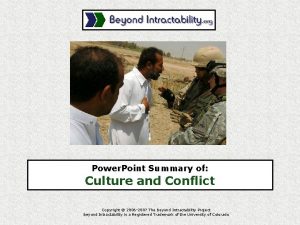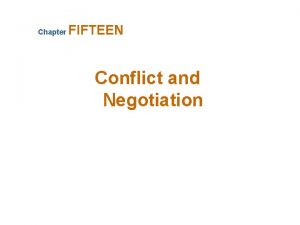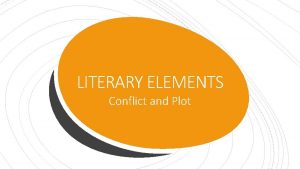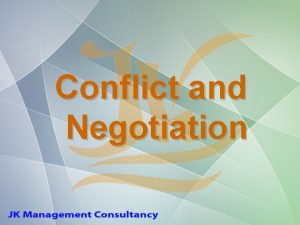Power Point Summary of Culture and Conflict Power












- Slides: 12

Power. Point Summary of: Culture and Conflict

Power. Point Summary of: Culture and Conflict Slide 2: Culture shapes our… • Perceptions • Judgments • Ideas of oneself and others Each of us belongs to multiple cultures Though powerful, culture often operates unconsciously

Power. Point Summary of: Culture and Conflict Slide 3: Cultural Messages… are what everyone in a group knows that outsiders don’t Consist of: • Starting points: assumptions, where we start our assessments of a situation • Currencies: those things we care about that influence and shape our interactions with others

Power. Point Summary of: Culture and Conflict Slide 4: Complications • Culture is multi-layered: What you see on the surface may mask differences below the surface. Thus, cultural generalizations are not the whole story. • Culture is in constant flux: As conditions change, cultural groups adapt. Thus, no comprehensive description of a culture can ever be formulated. • Culture is elastic: Knowing the cultural norms of a group doesn’t predict behavior of individuals within the group. Thus, taxonomies are of limited use.

Power. Point Summary of: Culture and Conflict Slide 5: More Complications • Culture is largely below the surface: It is not easy to access because it is largely outside our awareness. Thus, it is important to use multiple symbolic tools to communicate effectively. • Identities and influences vary in importance, depending on context: Misunderstood identities often become more important than others. Thus, interactive experiences should be pursued to limit misunderstandings.

Power. Point Summary of: Culture and Conflict Slide 6: Cultural Fluency… means familiarity with cultures and their dimensions

Power. Point Summary of: Culture and Conflict Slide 7: Communication “Starting Points” • High-context communication -most of a message is conveyed by the context surrounding it, not in explicit words • Low-Context communication -emphasizes directness rather than relying on context

Power. Point Summary of: Culture and Conflict Slide 8: Conflict “Starting Points” Ways of naming, framing and taming conflict • Naming -- refers to identifying what is and isn’t a conflict • Framing -- refers to interpretation of a conflict • Taming -- refers to norms on how to resolve a conflict

Power. Point Summary of: Culture and Conflict Slide 9: Ways of interpreting situations… or making starting points For example: • Universalist cultures rely on rules and laws • Particularist cultures consider exceptions and context

Power. Point Summary of: Culture and Conflict Slide 10: • Specific cultures examine specific situations, details, and outcomes • Diffuse cultures look at patterns, large-scale processes, and the “big picture”

Power. Point Summary of: Culture and Conflict Slide 11: • Inner-directed cultures see virtue in individual achievements, whereas • Outer-directed cultures see virtue in relationships and process

Power. Point Summary of: Culture and Conflict Slide 12: Individualists Collectivists See themselves as separate individuals Group allegiance is most important They prefer: • Competition • Self-reliance • Independence • Individual achievement • Personal growth and fulfillment They prefer: • Cooperation • Filial piety • Participation in shared progress • Reputation of the group
 Internal and external conflict worksheets
Internal and external conflict worksheets What is conflict and conflict resolution?
What is conflict and conflict resolution? External and internal conflict definition
External and internal conflict definition Non material culture examples
Non material culture examples Continuous culture and batch culture
Continuous culture and batch culture Indian vs american culture
Indian vs american culture Uses of selenite f broth
Uses of selenite f broth Folk culture and popular culture venn diagram
Folk culture and popular culture venn diagram Leisure
Leisure Indole test
Indole test Homework due today
Homework due today Lawn culture method
Lawn culture method Explain stab culture and stroke culture
Explain stab culture and stroke culture























